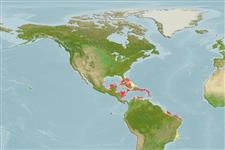Common names from other countries
Environment: milieu / climate zone / depth range / distribution range
Écologie
Récifal; saumâtre; profondeur 9 - 12 m (Ref. 108813). Tropical
Western Central Atlantic.
Length at first maturity / Taille / Poids / Âge
Maturity: Lm ? range ? - ? cm Max length : 50.0 cm TL mâle / non sexé; (Ref. 415)
Description synthétique
Morphologie
Laterally fused tubes running on branches (Ref. 81728): up to 50 cm long, 10 - 20 cm in diameter. Light to purplish brown externally, yellow to tan internally. The surface is smooth, with meandering groves occasionally. Oscules on the inner walls of the tubes few millimeters in diameter (Ref. 415).
Life cycle and mating behavior
Maturité | Reproduction | Frai | Œufs | Fécondité | Larves
Members of the class Demospongiae are hermaphroditic. Life cycle: The zygote develops into parenchymella larva (free-swimming) before settling down on a substrate where it grows into a young sponge.
Collin, R., M.C. Díaz, J. Norenburg, R.M. Rocha, J.A. Sánchez, M. Schulze, A. Schwartz and A. Valdés. 2005. (Ref. 415)
Statut dans la liste rouge de l'IUCN (Ref. 130435: Version 2024-1)
statut CITES (Ref. 108899)
Not Evaluated
Not Evaluated
Menace pour l'homme
Harmless
Utilisations par l'homme
| FishSource |
Outils
Plus d'informations
Taille/ÂgeCroissanceLongueur-poidsLongueur-longueurMorphologieLarvesAbondance
Sources Internet
Estimates based on models
Preferred temperature
(Ref.
115969): 26.1 - 28.1, mean 27 (based on 188 cells).
Vulnérabilité
Moderate vulnerability (40 of 100).
Catégorie de prix
Unknown.
